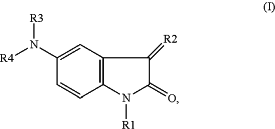| CPC C07D 207/38 (2013.01) [C07D 403/04 (2013.01); C07D 471/08 (2013.01); C07D 491/044 (2013.01); C07D 498/10 (2013.01)] | 21 Claims |
|
1. A method of treating a disease involving retinal dysfunction in a patient comprising administering to said patient a therapeutically effective amount of a compound having formula (I) or a pharmaceutically acceptable salt thereof:
 wherein:
R1 is C1-4-alkyl unsubstituted or substituted with MeO; tetrahydropyranyl, tetrahydrofuranyl, oxetanyl, dioxepanyl, pyrrolidinyl or piperidinyl; or
pyrrolidinyl or piperidinyl with the nitrogen substituted by methyl, isopropyl, oxetanyl, ethoxycarbonyl, acetyl, or trifluoroacetyl;
R2 is a 5-, 6- or 7-membered ring containing 1 or 2 heteroatoms selected from O or N bound in formula (I) by a C═C double bond,
in which one or both N-atoms can be substituted by methyl, isopropyl, acetyl, benzyloxycarbonyl, phenyl, oxetanyl or tetrahydropyranyl, and
in which one or more C-atoms can be substituted by -methyl or —OH;
R3 and R4 are independently from one another
hydrogen; C1-6-alkyl, unsubstituted or substituted with one or more F, methoxy, C3-8-cycloalkyl unsubstituted or substituted with one or more F; aryl; heteroaryl consisting of 5 to 6 ring atoms; or heterocyclyl selected from the group consisting of oxetanyl, tetrahydropyranyl and pyrrolidinyl, said heterocyclyl being unsubstituted or substituted with C1-6-alkyl, acetyl, tetrahydrofuranyl, oxetanyl or hydroxyethylacetyl;
or R3 and R4 together with the attached N form a heterocyclyl ring selected from the group consisting of morpholinyl and pyrrolidinyl both unsubstituted or substituted with C1-6-alkyl, F, or hydroxyl;
or R3 and R4 together represent one of the following groups:
 |